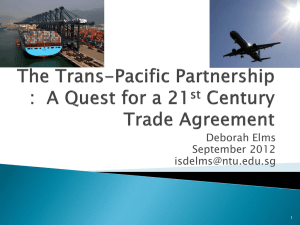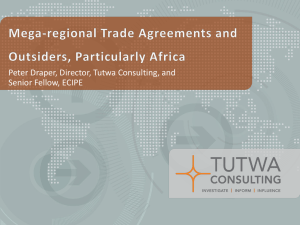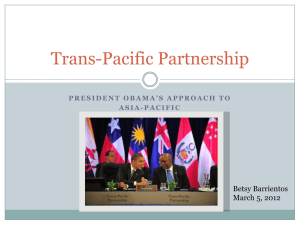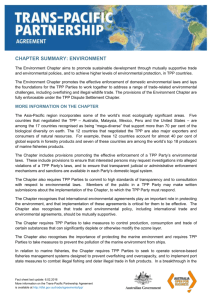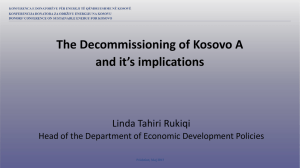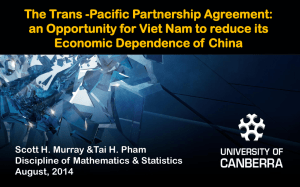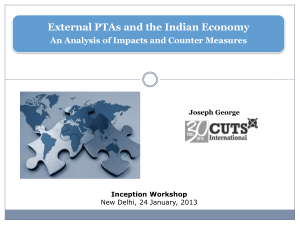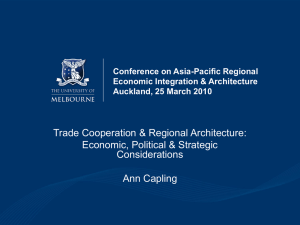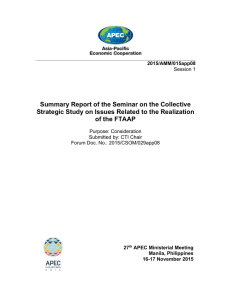References - Asia
advertisement
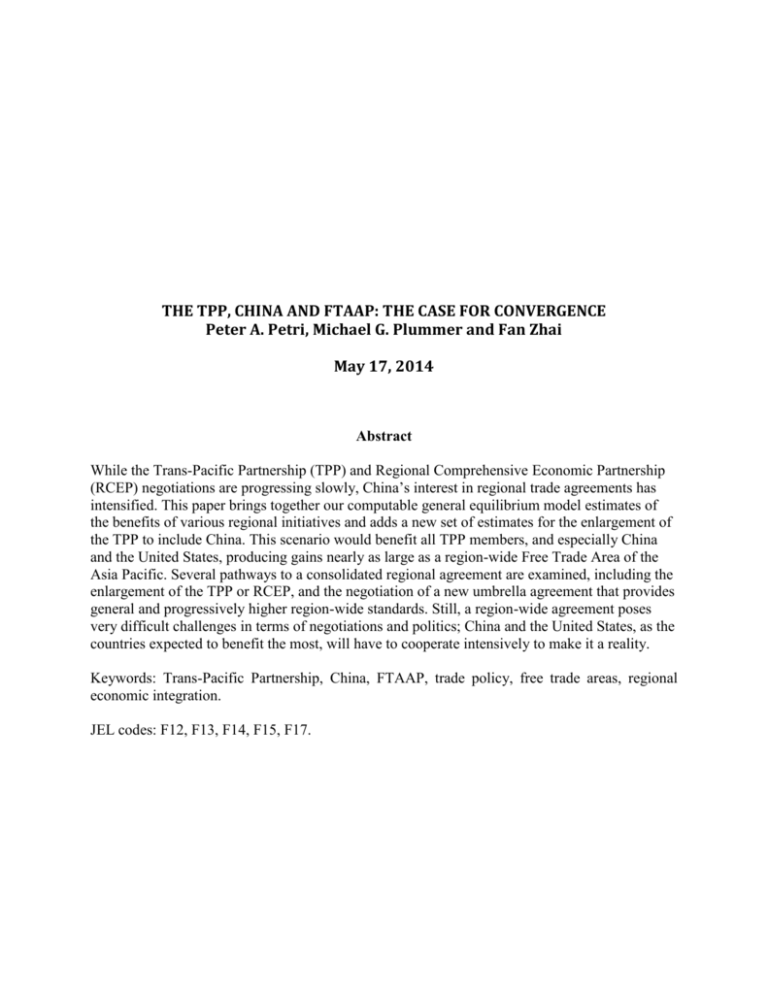
THE TPP, CHINA AND FTAAP: THE CASE FOR CONVERGENCE Peter A. Petri, Michael G. Plummer and Fan Zhai May 17, 2014 Abstract While the Trans-Pacific Partnership (TPP) and Regional Comprehensive Economic Partnership (RCEP) negotiations are progressing slowly, China’s interest in regional trade agreements has intensified. This paper brings together our computable general equilibrium model estimates of the benefits of various regional initiatives and adds a new set of estimates for the enlargement of the TPP to include China. This scenario would benefit all TPP members, and especially China and the United States, producing gains nearly as large as a region-wide Free Trade Area of the Asia Pacific. Several pathways to a consolidated regional agreement are examined, including the enlargement of the TPP or RCEP, and the negotiation of a new umbrella agreement that provides general and progressively higher region-wide standards. Still, a region-wide agreement poses very difficult challenges in terms of negotiations and politics; China and the United States, as the countries expected to benefit the most, will have to cooperate intensively to make it a reality. Keywords: Trans-Pacific Partnership, China, FTAAP, trade policy, free trade areas, regional economic integration. JEL codes: F12, F13, F14, F15, F17. THE TPP, CHINA AND FTAAP: THE CASE FOR CONVERGENCE Peter A. Petri, Michael G. Plummer and Fan Zhai Asia-Pacific trade negotiations are evolving more fitfully than expected a few years ago. The Trans-Pacific Partnership (TPP) negotiations are nearing the endgame, but divisions remain and political opposition is intense. The Regional Comprehensive Economic Partnership (RCEP) negotiations are at an earlier stage, but progress also appears to be slow, due to the region’s diversity and geopolitical strains. Nor are macroeconomic conditions—turning less favorable now in East Asia and not yet sufficiently improved in the Americas and Europe—especially conducive to new agreements. None of these factors is likely to prove fatal to large trade initiatives, but each adds uncertainty on what can be accomplished and when. These challenges have a silver lining: slow negotiations offer an opportunity to reexamine fundamental, long-term goals, including region-wide free trade through a Free Trade Area of the Asia Pacific (FTAAP). Work on these goals in the Asia-Pacific Economic Cooperation (APEC) forum and related venues has been episodic; it moved quickly with the Bogor Declaration and later with the negotiation of the P4 trade agreement among Brunei, Chile, New Zealand and Singapore, but has been also dormant at times. Institutions have lagged market-led integration. This suggests that innovations such as FTAAP have to be debated and nurtured well in advance of when they become feasible. This paper explores several such options, among them the expansion of the TPP to include China.1 Why the Asia Pacific? Asia Pacific trade is a logical setting for new agreements due to its scale and dynamism. First, the region’s trade is immense. Of the world’s $14 trillion in trade in 2010, $9 trillion involve APEC countries—a useful, though synthetic definition of the region—as either an exporter or importer or both. Within the APEC region, trade in the Americas amounted to $1 trillion, in Asia and Oceania $2 trillion, and across the Pacific also $2 trillion. The region comprises not only the world’s “factory floor” but also its most important sources of services, technology and investment, and final goods markets. Second, Asia-Pacific trade is dynamic, as demonstrated, for example, by its central role in innovations such as modern supply chains. The region’s diverse resource endowments and development levels give rise to varied specialization advantages. These are connected by dense transport and communication links for exchanging products, people and resources cheaply. 1 This possibility has been raised in recent commentary by Ma and Shi (2013) and Gordon (2014) among others. 2 Third, the region’s interest in formal linkages is clearly rising, spurred in part by the challenges of global negotiations. Before 2000 there were only four major trade agreements among APEC economies—the ASEAN Free Trade Area, the Canada-U.S. Free Trade area, the North American Free Trade Area, and the Australia-New Zealand Closer Economic Relations accord—while today they number in the 50s with others in the works (Figure 1). An especially strong uptick is now evident in agreements that connect the Pacific’s eastern and western sub-regions. Figure 1. Trends in Asia Pacific trade agreements 35 Number of agreements 30 25 20 15 10 5 0 Regional Trans-Pacific Note: among APEC members. Source: ESCAP database. Simdata/t-agree Uneven progress Despite the importance the Asia-Pacific trading system, the task of building regional institutions has been arduous. An Asian track for drafting new rules has proceeded slowly because the region’s economies have widely differing interests and some of its members have tense political relations. The Association of Southeast Asian Nations (ASEAN), the convener of the negotiations, is itself often divided on trade issues. Thus, even if an RCEP agreement is achieved in 2015, it may not go much beyond the bilateral deals that already crisscross the region. Meanwhile, a trans-Pacific track has laid out an ambitious agenda of negotiations since the United States made the TPP a priority in 2009. The group of negotiating partners has expanded from four in the initial P4 agreement to 12 at present. These partners are in principle “likeminded,” but their negotiations have been contentious due to their economic diversity. In addition, the leadership expected from the United States has been undermined by its domestic politics. In the run-up to the US elections, special interests from directly affected sectors in business, labor and civil society have assumed disproportionate voices in the trade debate. These disagreements feed into much suspicion of globalization in the United States, and some public 3 interest groups portray trade agreements as serving only corporate interests. As a recent PewBertelsmann trade policy poll noted, there is a double deficit: “lack of understanding and a lack of trust” (Pew Research Center and Bertelsmann Foundation, 2014). Hopes for an agreement in 2014 have faded. None of this makes region-wide trade rules less urgent. The backlog of issues accumulated since the Uruguay Round was completed 20 years ago continues to expand and the growth of world trade is slowing. The mega-regional negotiations offer potential answers to these issues, but they will need to be supported by strong arguments by leaders as well as policies that ensure that the benefits are widely shared. Given improvements in macroeconomic conditions and reduced geopolitical tensions, the logic of region-wide trade rules should reemerge. In the meantime, there is good reason to search for pathways to full regional integration. China’s year as the host of APEC creates excellent opportunities for this work. Benefits from the TPP and its enlargement The gains from Asia-Pacific free trade agreements cannot be predicted with precision—for one thing, their terms are in flux. In recent studies we nevertheless applied an advanced general equilibrium model to estimate approximate benefits for several potential agreements, including the 12-member TPP, the 16-member RCEP, and the 21-member FTAAP. These studies found, as reported below, that the greatest economic benefits were associated with agreements that spanned China and the United States. In this paper we add a new variant to previous simulations, an enlargement of the TPP to include China. Specifically, we hypothesize that the TPP will be eventually expanded to 17 members to include China, Indonesia, Korea, the Philippines, and Thailand (see Figure 2). All five have expressed some interest in such an expansion and, as we shall see, the results suggest compelling benefits for them. The modeling approach is explained in Petri, Plummer and Zhai (2012) and on the website asiapacifictrade.org. We use a novel computable general equilibrium (CGE) framework developed by Zhai (2008) that incorporates firm-level differences in productivity. The version we use has 24 regions and 18 sectors, and also includes special detail on trade agreements and trade policy provisions in the Asia-Pacific region. 4 Figure 2. Schematic view of Asian and Trans-Pacific tracks FTAAP RCEP India Cambodia Laos Myanmar Australia Brunei Japan Malaysia New Zealand Singapore Vietnam China Indonesia Korea Philippines Thailand Russia Taiwan Canada Chile Mexico Peru United States TPP 12 TPP 17 Source: authors. We assume that future agreements will be based on templates similar to those of past agreements. Thus, the TPP’s template is assumed to be similar to the Korea-US free trade agreement, and RCEP’s template to those of agreements recently concluded by ASEAN. The TPP and RCEP templates differ on issues such as government procurement, intellectual property rights, investment, and competition, as well as the depth of liberalization of tariff and non-tariff barriers. These differences are not accidental; US agreements seek market access for leading sectors such as services and intellectual property, while Asian agreements focus on goods, consistent with their comparative advantages. We assume a FTAAP that would bridge these objectives with an intermediate template. Pairs of economies covered by more than one agreement are assumed to use—and benefit from—the one with the strongest provisions. The results of these simulations are summarized in Table 1. These results should be viewed as mainly qualitative (they indicate relative gains) rather than precisely quantitative (since they are subject to many uncertainties and errors). In particular, three main conclusions of the comparisons are reasonably robust to alternative formulations and estimates. First, the benefits of Asia-Pacific integration are large; for the most comprehensive agreements income gains could approach $2 trillion, or nearly 2 percent of world GDP in 2025. But even the current negotiations on the TPP-12 and RCEP would generate substantial gains. RCEP shows larger benefits than the TPP, mainly due to our optimistic assumption that it will liberalize economic relations among China, India, Japan and Korea. 5 Table 1. Income gains under alternative scenarios GDP 2025 ($2007bill) Template quality Americas Canada Chile Mexico Peru United States Asia Brunei China Hong Kong India Indonesia Japan Korea Malaysia Philippines Singapore Chinese Taipei Thailand Vietnam Other ASEAN Oceania Australia New Zealand Others Europe Russia ROW WORLD TPP-12 High Income gain ($2007 bill) TPP-17 RCEP FTAAP InterHigh Moderate mediate TPP-12 High % Baseline GDP TPP-17 RCEP High FTAAP InterModerate mediate 24,867 101.7 468.0 2.5 373.3 0.4 1.9 0.0 1.5 1,978 292 2,004 320 20,273 8.7 2.5 9.9 3.9 76.6 33.2 7.8 91.1 8.4 327.6 -0.1 0.0 2.8 0.0 -0.1 26.2 6.5 67.7 6.3 266.5 0.4 0.9 0.5 1.2 0.4 1.7 2.7 4.5 2.6 1.6 0.0 0.0 0.1 0.0 0.0 1.3 2.2 3.4 2.0 1.3 34,901 125.2 1442.1 627.0 1354.3 0.4 4.1 1.8 3.88 20 17,249 406 5,233 1,549 5,338 2,117 431 322 415 840 558 340 83 0.2 -34.8 -0.5 -2.7 -2.2 104.6 -2.8 24.2 -0.8 7.9 -1.0 -2.4 35.7 -0.4 1.7 808.6 -1.9 -29.3 82.0 237.3 136.3 45.4 30.6 27.1 -31.5 64.9 71.9 -1.1 1.2 249.7 46.8 91.3 17.7 95.8 82.0 14.2 7.6 2.4 -16.1 15.5 17.3 1.6 1.1 678.1 84.9 -29.5 38.0 228.1 129.3 38.4 15.9 13.6 53.0 27.4 72.9 3.1 0.9 -0.2 -0.1 -0.1 -0.1 2.0 -0.1 5.6 -0.2 1.9 -0.1 -0.4 10.5 -0.4 8.4 4.7 -0.5 -0.6 5.3 4.4 6.4 10.5 9.5 6.5 -3.8 11.6 21.2 -1.3 5.8 1.4 11.5 1.7 1.1 1.8 3.9 3.3 2.3 0.6 -1.9 2.8 5.1 1.9 5.5 3.9 20.9 -0.6 2.5 4.3 6.1 8.9 5.0 3.3 6.3 4.9 21.5 3.74 1,634 10.7 41.3 21.7 32.1 0.7 2.5 1.3 2.0 1,433 201 6.6 4.1 34.1 7.2 19.8 1.9 26.4 5.8 0.5 2.0 2.4 3.6 1.4 0.9 1.8 2.9 41,820 -14.1 -43.4 -6.8 162.0 0.0 -0.1 0.0 0.4 22,714 2,865 16,241 -3.7 -1.4 -9.0 0.9 -8.8 -35.5 5.1 -5.3 -6.6 -32.6 265.9 -71.4 0.0 0.0 -0.1 0.0 -0.3 -0.2 0.0 -0.2 0.0 -0.1 9.3 -0.4 103,223 223.4 1908.0 644.4 1921.7 0.2 1.8 0.6 1.9 33,045 36,535 58,951 285.0 137.4 239.2 892.8 1516.8 1973.0 155.1 617.9 553.0 759.5 1248.5 2052.0 0.9 0.4 0.4 2.7 4.3 3.3 0.5 1.8 0.9 2.3 3.5 3.5 Memorandum TPP-12 RCEP APEC Notes: from scenarios reported on asiapacifictrade.org. The template used to represent the TPP-17 is more rigorous than the one used to simulate the FTAAP agreement. Thus the difference between the two scenarios is partly explained by differences in membership and partly by the more extensive liberalization assumed under the TPP process. For further explanation, see footnote 2. Second, the results suggest divergences among the interests of economies. The TPP-12 favors economies that do not yet have an FTA with the United States, such as Vietnam and Japan. RCEP favors China, India, Japan and Korea, assuming that trade among them would be effectively covered by an FTA. ASEAN economies, however, would gain modestly from RCEP, assuming that the agreement does not substantially improve the FTAs that already cover all of 6 the region’s trade flows. Finally, the TPP-17 would offer large benefits to China, the United States, and others that gain access to both TPP and RCEP preferences. Third, potential gains increase sharply with the scale of integration. For example, expanding the TPP from 12 to 17 members would triple global benefits from $285 billion to $893 billion in 2025. Since that expansion would include most large economies in the FTAAP, overall gains would be similar.2 Moreover, gains will depend on the quality of the template; in other work, we show that global FTAAP benefits would be $2.4 trillion with a TPP-style template vs. $1.9 trillion with the intermediate template of Table 1. Moreover, all APEC economies save Hong Kong and Chinese Taipei (excluded from the TPP-17) do better under the TPP-17 than the FTAAP, in large part due to the former’s deeper template. The vast majority of gains in all cases would reflect trade-creation rather than the diversion of benefits from excluded economies. Possible pathways Regardless of the potential gains, large agreements that include both China and the United States face formidable challenges in terms of negotiations as well as politics. They will not emerge quickly and will require ample preparation through reforms, innovative cooperation and greater mutual trust. It is therefore important to consider pathways that could lead to convergence in the longer term. Two broad alternatives are considered below. First, either the TPP or the RCEP could emerge as pathways to region-wide free trade. The TPP is at this time the most probably pathway. It might initially expand to 17 members, as discussed above. Such enlargement would yield very positive outcomes for old and new members. China and the United States would reap the largest benefits, providing incentives for their joint leadership. Of course, many difficulties would be involved; China would have to accept provisions that were not included in its previous FTAs, and the United States would face large domestic adjustments that require careful implementation and confident leadership. Nevertheless, this path offers major political and economic opportunities for both countries and some highlevel attention is already directed toward it.3 Whether RCEP will emerge as an alternative pathway is still open to question; much will depend on whether it achieves the high standards expected by advanced economies. Second, the TPP and RCEP could develop in parallel, with an eventual “umbrella agreement” built around them. That agreement, often envisioned as the FTAAP, would impose new requirements that are intermediate to those of the TPP and RCEP. For example, it could specify 2 The TPP-17 and FTAAP simulations differ both in terms of their template (the TPP-17 template is assumed to be more rigorous) and membership (the FTAAP has 21 members). These differences complicate direct comparisons of the results. For China, for example, the gains are greater under the high standards of the TPP-17 than under the wider coverage of the FTAAP. The same is true for the United States. For Chinese Taipei, however, gains are greater under the FTAAP than the TPP-17 because Taiwan is not assumed to be part of the latter. 3 These possibilities were explicitly noted, for example, by Wang Shouwen, Assistant Commerce Minister, and Lin Yifu, Vice Chairman of the All-China Federation of Industry and Commerce, speaking at the Boao Forum on April 9, 2014 (see http://www.businesstimes.com.sg/breaking-news/asia/china-says-watching-trans-pacific-trade-pactgreat-interest-20140409 and http://www.aastocks.com/en/stocks/analysis/china-hot-topiccontent.aspx?id=200000331986&type=18&catg=3, respectively). 7 intermediate tariff reductions, service commitments, and intellectual property rules. It would in turn offer benefits more modest than those offered by the TPP. This approach would yield an initially multi-tiered system, with economies choosing whether to accept RCEP, FTAAP or TPP standards, but with the expectation that each economy would eventually converge to high standards. This is most likely to happen by adding economies gradually to the TPP. Another possibility is that the FTAAP becomes a living agreement that is upgraded over time. Precedents for an evolutionary approach are offered by ASEAN’s experience with combining “plus one” agreements and bilateral agreements with external partners, and with its upgrading of the ASEAN Free Trade Area and some ASEAN-plus-one partnerships. Unfortunately, US political precedents are harder to find. An effective multi-tiered system would require its several agreements to be reasonably compatible. There is some evidence that recent trade agreements by the United States and Asian economies are more similar than earlier ones, and that agreements increasingly borrow language from each other. The guidelines for RCEP, for example, overlap with the structure of the TPP. In any case, the attitudes of China and the US will be crucial. Much of the incremental gains from a region-wide agreement would accrue to these economies, and their cooperation and leadership will be essential for bridging the Asian and trans-Pacific tracks. More work is needed to analyze the details of these alternatives, but APEC provides an ideal venue for such dialogue. Conclusions Asian and trans-Pacific regional negotiations are moving forward, despite business cycles, elections, geopolitics, and political controversy. Estimates suggest that they could generate large economic benefits, especially if they ultimately encompass the entire region. The gains from Asia-Pacific integration will depend on the quality and regional reach of the templates used. There is tension between these objectives. A rigorous template, as is emerging in the trans-Pacific negotiations, yields greater gains, but will also impede region-wide participation. But there are ways to bridge these alternatives, for example, through the multi-track, multi-tiered process sketched above. Detailed policy recommendations are well beyond the scope of this short paper, but three issues merit attention: APEC could use the current lull in negotiations to intensify work on region-wide integration, including the FTAAP. New policy dialogues and research efforts might be directed, for example, toward minimizing divergences between emerging agreements. The TPP and RCEP agreements could develop “mutual accession” clauses—that is, commitments to consider expeditiously applications from each other’s members. They could also identify future windows for enlargement. These provisions need not guarantee accession, but making timetables explicit would motivate planning. 8 China and the United States could intensify their “third track” of cooperation, leading to milestones such as an early bilateral investment agreement, joint support for key plurilateral agreements in the WTO, and steps toward joint membership in Asia-Pacific agreements such as the TPP and FTAAP. Region-wide agreements could produce compelling economic benefits and a more cooperative political environment. Yet achieving such agreements is difficult. Lengthy and complex negotiations will be required and, amplified by the internet, these invite opposition from numerous special interests. The case for Asia-Pacific integration will have to be made effectively by governments, especially in the largest economies, if its benefits are to be realized. References Gordon, B. (2014, April 24). China Belongs in the Pacific Trade Pact. Wall Street Journal. Kehoe, Timothy J., 2005. "An Evaluation of the Performance of Applied General Equilibrium Models on the Impact of NAFTA." in T.J. Kehoe, T.N. Srinivasan, and J. Whalley, eds. Frontiers in Applied General Equilibrium Modeling: In Honor of Herbert Scarf, Cambridge: Cambridge University. pp. 341-77. Li, Chunding and John Whalley, 2012. "China and the TPP: A Numerical Simulation Assessment of the Effects Involved," NBER Working Paper No. 18090, May. Ma, J., & Shi, A. (2013). Economic benefits of TPP entry for China. Deutsche Bank, Hong Kong. Petri, Peter A., Michael G. Plummer and Fan Zhai. 2012. The Trans-Pacific Partnership and Asia-Pacific Integration: A Quantitative Assessment. Policy Analysis in International Economics No. 98. Washington: Peterson Institute for International Economics and EastWest Center. Pew Research Center and Bertelsmann Foundation. (2014). Creating a Transatlantic Marketplace: German and American Views. Washington, D.C. Zhai, Fan, 2008, “Armington Meets Melitz: Introducing Firm Heterogeneity in a Global CGE Model of Trade,” Journal of Economic Integration, 23(3), September, pp. 575-604. 9
